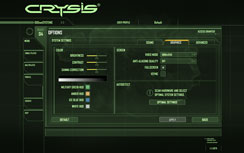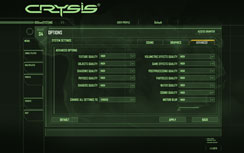HIS (AMD) ATI Radeon HD 4830 512MB
Written by Tim Smalley
October 30, 2008 | 09:17
Tags: #4830 #benchmark #benchmarks #gpu #graphics-card #load #performance #power-consumption #radeon #tested #testing

Crysis
Publisher: Electronic ArtsWhat can we say about this game that hasn’t been said already? Crysis was probably the most anticipated game on the PC last year and was released on November 16th 2007.
Crysis is seen by many as the poster boy for DirectX 10 and it will make your system cry, quite literally – it’s a monster! It doesn’t come as much of a surprise then, that the graphics are something special – they’re above and beyond anything we’ve ever seen in a PC game.
We tested the game using the 64-bit executable under both DirectX 9.0 and DirectX 10 with the 1.21 patch applied. We used a custom timedemo recorded from the Laws of Nature level which is more representative of gameplay than the built-in benchmark that renders things much faster than you're going to experience in game. We found that around 27-33 fps in our custom timedemo was sufficient enough to obtain a playable frame rate through the game. It's a little different to other games in that the low frame rates still appear to be quite smooth.
For our testing, we set all quality details to High and forced 8x anisotropic filtering in the driver menu as there is currently no support for it in game. We tested at 1,280 x 1,024, using 0x, 2x and 4x anti-aliasing, 1,680 x 1,050 using 0x and 4x anti-aliasing, 1,920 x 1,200 using 0x and 2xAA and 2,560 x 1,600 with 0xAA. By extensively testing using anti-aliasing in very high resolutions, we'll be pushing even the bleeding edge hardware on test to the limit.
Crysis
1280x1024 0xAA 8xAF, DX9, High Detail
- ATI Radeon HD 4870 X2
- Nvidia GeForce GTX 280
- Nvidia GeForce GTX 260+
- ATI Radeon HD 4870 1GB
- ATI Radeon HD 4870 512MB
- Nvidia GeForce GTX 260
- ATI Radeon HD 3870 X2
- Nvidia GeForce 9800 GTX+
- ATI Radeon HD 4850
- Nvidia GeForce 8800 GT
- ATI Radeon HD 4830
-
-
78.6
-
35.0
-
-
-
56.0
-
33.0
-
-
-
49.0
-
29.0
-
-
-
46.1
-
25.0
-
-
-
45.9
-
26.0
-
-
-
45.8
-
27.0
-
-
-
44.2
-
21.0
-
-
-
39.0
-
23.0
-
-
-
36.3
-
20.0
-
-
-
30.5
-
18.0
-
-
-
30.3
-
17.0
-
0
10
20
30
40
50
60
70
80
Frames Per Second
-
Average
-
Minimum
Crysis
1280x1024 2xAA 8xAF, DX9, High Detail
- ATI Radeon HD 4870 X2
- Nvidia GeForce GTX 280
- Nvidia GeForce GTX 260+
- Nvidia GeForce GTX 260
- ATI Radeon HD 4870 1GB
- ATI Radeon HD 4870 512MB
- ATI Radeon HD 3870 X2
- Nvidia GeForce 9800 GTX+
- ATI Radeon HD 4850
- Nvidia GeForce 8800 GT
- ATI Radeon HD 4830
-
-
66.3
-
31.0
-
-
-
51.1
-
31.0
-
-
-
44.2
-
26.0
-
-
-
41.9
-
24.0
-
-
-
38.8
-
23.0
-
-
-
38.1
-
23.0
-
-
-
33.3
-
17.0
-
-
-
33.2
-
19.0
-
-
-
29.3
-
17.0
-
-
-
26.5
-
16.0
-
-
-
24.7
-
14.0
-
0
10
20
30
40
50
60
70
Frames Per Second
-
Average
-
Minimum
Crysis
1280x1024 4xAA 8xAF, DX9, High Detail
- ATI Radeon HD 4870 X2
- Nvidia GeForce GTX 280
- Nvidia GeForce GTX 260+
- Nvidia GeForce GTX 260
- ATI Radeon HD 4870 1GB
- ATI Radeon HD 4870 512MB
- ATI Radeon HD 3870 X2
- Nvidia GeForce 9800 GTX+
- ATI Radeon HD 4850
- Nvidia GeForce 8800 GT
- ATI Radeon HD 4830
-
-
63.4
-
33.0
-
-
-
48.3
-
29.0
-
-
-
41.7
-
25.0
-
-
-
39.6
-
23.0
-
-
-
37.7
-
21.0
-
-
-
36.7
-
22.0
-
-
-
32.7
-
17.0
-
-
-
30.2
-
17.0
-
-
-
28.0
-
16.0
-
-
-
24.2
-
14.0
-
-
-
23.8
-
13.0
-
0
10
20
30
40
50
60
70
Frames Per Second
-
Average
-
Minimum
Crysis
1680x1050 0xAA 8xAF, DX9, High Detail
- ATI Radeon HD 4870 X2
- Nvidia GeForce GTX 280
- Nvidia GeForce GTX 260+
- ATI Radeon HD 4870 1GB
- ATI Radeon HD 4870 512MB
- Nvidia GeForce GTX 260
- ATI Radeon HD 3870 X2
- Nvidia GeForce 9800 GTX+
- ATI Radeon HD 4850
- Nvidia GeForce 8800 GT
- ATI Radeon HD 4830
-
-
58.5
-
27.0
-
-
-
44.6
-
29.0
-
-
-
39.1
-
25.0
-
-
-
37.0
-
22.0
-
-
-
36.6
-
22.0
-
-
-
36.5
-
23.0
-
-
-
31.9
-
16.0
-
-
-
31.3
-
19.0
-
-
-
29.0
-
17.0
-
-
-
24.6
-
15.0
-
-
-
24.2
-
14.0
-
0
10
20
30
40
50
60
Frames Per Second
-
Average
-
Minimum
Crysis
1680x1050 4xAA 8xAF, DX9, High Detail
- ATI Radeon HD 4870 X2
- Nvidia GeForce GTX 280
- Nvidia GeForce GTX 260+
- Nvidia GeForce GTX 260
- ATI Radeon HD 4870 1GB
- ATI Radeon HD 4870 512MB
- ATI Radeon HD 3870 X2
- ATI Radeon HD 4850
- Nvidia GeForce 9800 GTX+
- ATI Radeon HD 4830
- Nvidia GeForce 8800 GT
-
-
46.8
-
23.0
-
-
-
38.4
-
25.0
-
-
-
33.2
-
21.0
-
-
-
31.5
-
20.0
-
-
-
30.1
-
18.0
-
-
-
28.0
-
17.0
-
-
-
23.5
-
10.0
-
-
-
21.9
-
13.0
-
-
-
19.9
-
11.0
-
-
-
18.5
-
11.0
-
-
-
16.6
-
9.0
-
0
10
20
30
40
50
Frames Per Second
-
Average
-
Minimum
Crysis
1920x1200 0xAA 8xAF, DX9, High Detail
- ATI Radeon HD 4870 X2
- Nvidia GeForce GTX 280
- Nvidia GeForce GTX 260+
- ATI Radeon HD 4870 1GB
- ATI Radeon HD 4870 512MB
- Nvidia GeForce GTX 260
- ATI Radeon HD 3870 X2
- Nvidia GeForce 9800 GTX+
- ATI Radeon HD 4850
- Nvidia GeForce 8800 GT
- ATI Radeon HD 4830
-
-
46.8
-
21.0
-
-
-
35.9
-
23.0
-
-
-
31.4
-
20.0
-
-
-
29.6
-
17.0
-
-
-
29.3
-
17.0
-
-
-
29.2
-
18.0
-
-
-
25.6
-
13.0
-
-
-
25.1
-
15.0
-
-
-
22.7
-
13.0
-
-
-
19.9
-
11.0
-
-
-
19.1
-
11.0
-
0
10
20
30
40
50
Frames Per Second
-
Average
-
Minimum
Moving to DirectX 9.0 mode doesn't improve things a great deal, although the frame rates are higher meaning you're less likely to find yourself lowering in-game settings. At 1,280 x 1,024 0xAA, both the Radeon HD 4830 and GeForce 8800 GT perform similarly - there's less than half a frame per second separating the two and that's definitely not going to make a difference in real-world gameplay.
Interestingly, the GeForce 8800 GT manages to just about hold onto playability when 2xAA is enabled at the same resolution, but sadly the Radeon HD 4830 doesn't. Looking further afield, both the 4850 and 9800 GTX+ achieve playability at 1,680 x 1,050 0xAA - the advantage is with Nvidia's card, but the Radeon HD 4850 is a cheaper option generally speaking.











Want to comment? Please log in.